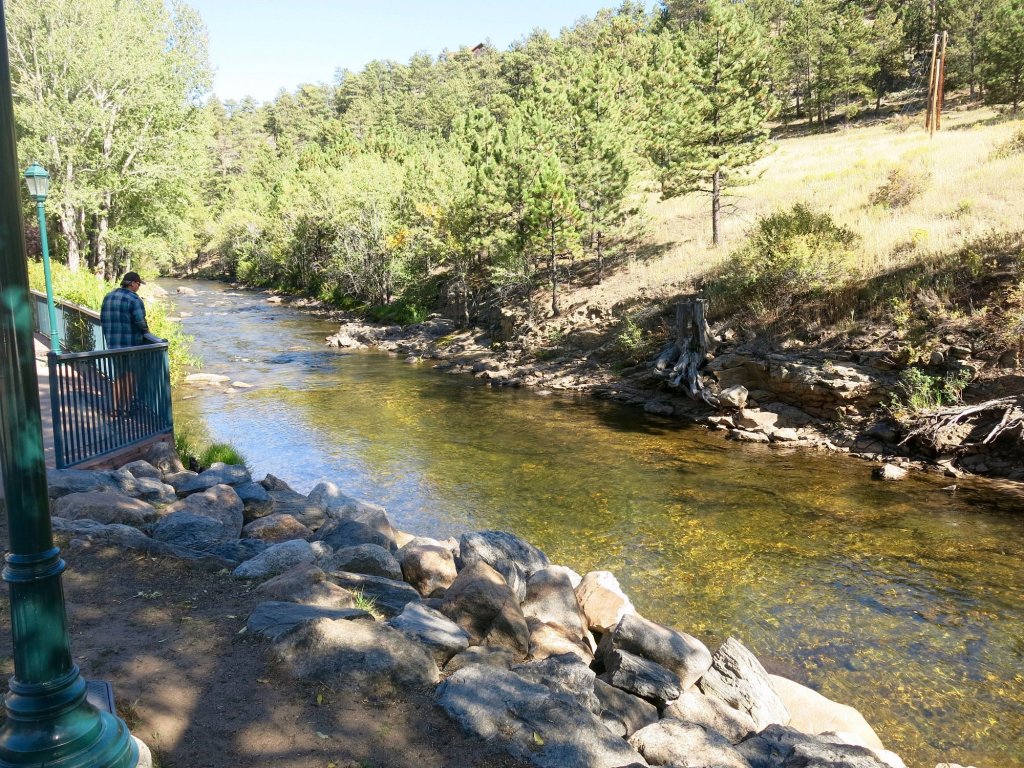When someone says Estes Park, I see Jack Nicholson shoving his face through an ax-battered door screaming, “Here’s Johnny!”
My apologies for the visual; it’s a personal struggle, and it’s incredibly unfair to Estes Park.
Although The Shining was filmed at the maybe-haunted Stanley Hotel in Estes Park, this Colorado town couldn’t be further from a Stephen King novel.
It’s charming, it’s welcoming to visitors, it’s chock-full of great rentals, and it’s got something (amazing) to do any time of year.
And while you absolutely can take a The Shining-themed tour of The Stanley Hotel (or even join a séance with the hotel’s resident apparitionist), you’re better off spending your time enjoying the fruits of the Rockies.
Ready to see a ghost at The Stanley Hotel lace up your hiking boots? These are the best outdoor activities that you can enjoy in any season, including in winter.
6 best outdoor activities in Estes Park
Great for the family: Geocaching

Geocaching has popped up on my radar more and more over the last year, especially when it comes to activities offered at national parks. (In fact, I recently covered geocaching at Babcock State Park in a piece on Fayetteville, West Virginia.)
If you’ve been seeing this phrase around and wondering what it means, geocaching is basically a digital scavenger hunt.
Park authorities leave out ‘caches’ that park-goers can find using clues accessed on a mobile device, then leave behind for other groups to uncover.
In Estes Park, you can enjoy Rocky Mountain National Park’s unique Across the Divide Geocaching program. It’s part of an international program called GeoTours, which means this is an activity your family can take with you on future journeys.
Just make sure you read up on how Geocaching works and what you’ll need to get started. Every park has a unique approach to GeoAdventures.
Romantic side quests: Horseback Riding

Depending on how adventurous you are, and how willing you are to laugh at yourself, horseback riding may or may not make for a great date.
Personally, I love these types of dates because they take me out of my comfort zone while promising an unforgettable adventure.
In Estes Park, you’ll get even more out of the experience thanks to the gorgeous views and range of options. You can choose from five different horse-riding experiences that are geared toward beginners, experienced riders, and those who want to get out in nature.
Personally, I’d go for the National Park Gateway Stables—it looks like one of the most scenic options.
Big group adventures: Wildlife Watching

Estes Park is one of the best places in the United States to observe wildlife without disappearing into the wilderness. That’s thanks to the Rockies’ looming presence; they pen in the town and are protected as part of Rocky Mountain National Park.
Just outside city limits, wildlife abounds.
It might sound a little counterintuitive to recommend taking a big group to observe wildlife—after all, should you be in small, sort of clandestine groups?
Not exactly. If you’re just passing through Estes Park, you’ll probably be looking for wildlife from a car.
If you’re a larger group, you can easily explore scenic routes that are known for wildlife in two cars. That way, your group experiences the same magic without packing into a bus.
The best way to see wildlife is in Rocky Mountain National Park and Estes Valley—but the likelihood of you seeing wildlife changes greatly based on season, along with where you might see them.
For this reason, always ask guides, hosts, or your hotel’s concierge about when and where to go wildlife watching.
For the outdoorsy types: Whitewater Rafting

As with horseback riding, you have choices when it comes to white water rafting operators in Estes Park. Most service the rushing Colorado River or the nearby Poudre River. Once again, you’ll be able to find a difficulty level that suits your experience on the water.
Want to take it easy? You can basically float down certain portions of either river. Want to challenge yourself? Take on rapids with names like Maw of Death and Roller Coaster.
For the non-outdoorsy types: Riverwalk

Even if you hate the outdoors, you’ll still have fun in Estes Park. Let me mention once again just how stunning the Rocky Mountain views are—the town is almost surrounded on all sides by protected forests, meaning you can soak up the rugged atmosphere from downtown.
Speaking of downtown, it’s home to a quaint Riverwalk. The Riverwalk crisscrosses the Big Thompson River and Fall River, which wind through the center of town. As you weave along the path, you can explore Estes Park’s most beloved galleries, shops, and restaurants. It’s so relaxing and scenic that you might actually do it twice.
Perfect for a solo trip: Choose your tour

More rugged outdoor trips aren’t usually a top pick for solo travelers—especially greener, first-time soloists. Getting out into nature is rejuvenating, but it also requires us to gather the right gear, take the necessary precautions, and otherwise plan out every detail in case we lose cell service or run into a bear.
In Estes Park, however, you can easily find a tour that suits your outdoor interests. From photography tours that take you into Rock Mountain National Park to llama-led adventures to guided bike tours, there’s something for everyone. Best of all, it’s a great place to meet fellow travelers and make friends that you might see again.
The surprise of a lifetime: Off Roading or Open Air Adventure Park

Can’t be bothered with another horseback ride or white water adventure? Take things in a new direction. In Estes Park, you have two unexpected options: a daring offroad adventure or the Open Air Adventure Park.
Off-roading options let you take on nature with the help of rough-and-ready rock crawlers, from Jeeps to customized rides. Some are large enough to bring on small groups, making this an ideal pick for bachelor parties.
The Open Air Adventure Park gives you a little bit of everything. You can take on an obstacle course, rent a kayak to take a sunset tour, throw axes like a Viking, and more. Best of all, you’re surrounded by stunning natural forests.
